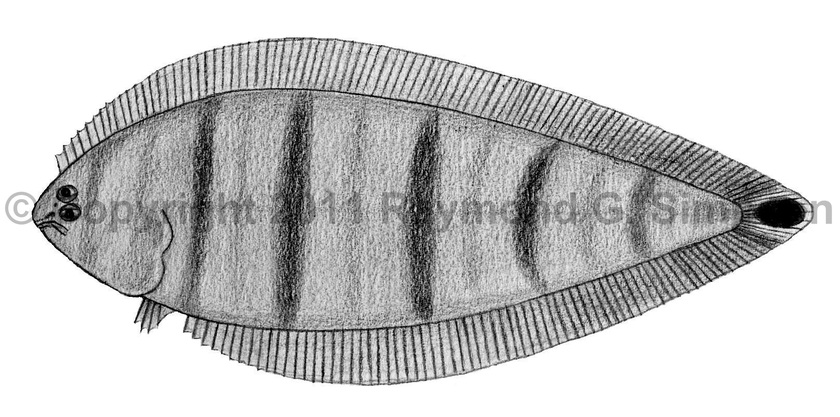
Common Name
Spottail Tonguefish
Year Described
Ginsburg, 1951
Identification
Dorsal Fin Rays: 82-90
Anal Fin Rays: 64-74
Pectoral Fin Rays: none
Pelvic Fin Rays: 4
Caudal Fin Rays: 11
Longitudinal Scale Rows: 67-82
Vertebrae: 44-48
Pterygiophore pattern (1st three interneural spaces): 1-4-3
Other diagnostic characters include: well developed pupillary operculum, ocular side upper jaw usually toothless, ocular side lower jaw with a fleshy ridge present, and scales usually absent from blind side dorsal and anal fins (sometimes with 1-2 scales on posterior fins in large adults).
Color
Dark brown with 4-11 distinct darker crossbands on body, not continuing onto fins. Dorsal and anal fins dark brown with no obvious markings. Peritoneum unpigmented. Caudal fin with a obvious black, ocellated spot. Blind side pale without melanophores.
Size
Mature adults from 101-150mm. Maximum size to 166mm.
Habitat
Shallower habitats from 5-324m (usually <40m), over live bottoms. Not in estuaries.
Range Map

Range
The SE U.S. from NC to the Gulf of Mexico. There is a record from Cuba.
References
Munroe, T.A. 1998. Systematics and ecology of western Atlantic tonguefishes (Symphurus: Cynoglossidae: Pleuronectiformes). Fish. Bull. 96(1):1-182.
Munroe, T. A. 2003. Bothidae (Pp. 1885-1895), Scophthalmidae (Pp. 1896-1897), Paralichthyidae (Pp. 1898-1921), Poecilopsettidae (Pp. 1922-1923), Achiridae (Pp. 1925-1933), Cynoglossidae (Pp. 1934-1959). In: Carpenter. 2003. The living marine resources of the Western Central Atlantic v. 3.